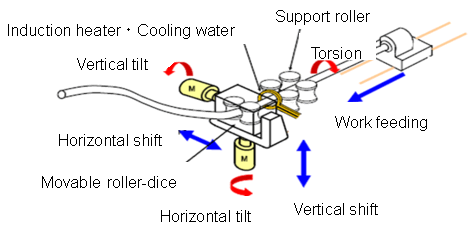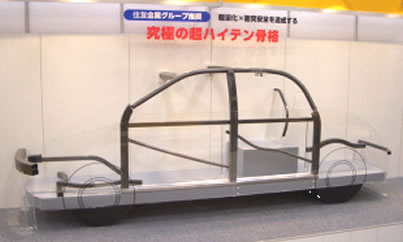Sumitomo Metals Develops Three-Dimensional Hot Bending Quench Mass Processing Technology
- First in the World to Develop Ultra High-tensile Strength Technology for Hollow Tubular Structures Using Steel-
2009.10.13
- Sumitomo Metal Industries, Ltd.
Sumitomo Pipe & Tube Corporation
Sumitomo Metal Industries, Ltd. and Sumitomo Pipe & Tube Corporation (the Sumitomo Metals Group, hereafter) have developed the world's first Three-Dimensional Hot Bending and Quench (3DQ)(*1) mass processing technology, which enables the formation of automotive parts with a tensile strength of 1470 MPa or more. This technology enables steel components with a hollow tubular structure(*2) to acquire ultra high-tensile strength. Application of this technology reduces weight of automotive parts by 30-50% and improves crash safety, compared to conventional methods. It is also expected to lead to technologies for space frame body structures(*3) in the future.
1. Background
In recent years, the automotive industry has been focusing on two issues: development of lighter vehicles to improve fuel economy, in an effort to prevent global warming; and improvement in crash safety. The Sumitomo Metals Group has developed 3DQ mass processing technology as a means of satisfying these two conflicting needs. The technology enables materials with a hollow tubular structure, a major component of a vehicle body, to gain ultra high-tensile strength and the manufacture of components in three-dimensional complex shapes. We are the first in the world to have achieved this.
2. Summary and major features of the development
The Sumitomo Metals Group's new technology has enabled the manufacture of automobile components with a hollow tubular structure of as high as 1470MPa high-tensile strength made by steel , for the first time in the world. When using previous technologies, the maximum high-tensile strength achieved was 980MPa.
The new technology enables such components with complex shapes to be manufactured in one process: some selected steel tube parts are heated and quenched with cooling water, while a bending moment is simultaneously applied to the steel pipe with a movable roller-dice so that the pipe bends.

[Three Dimensional Hot Bending and Quench(3DQ)mass processing technology]
This 3DQ technology is a consecutive forming method that allows three-dimensional complex hot bending and quenching at the same time. It has produced effects that are hard to achieve with conventional hydroforming and other cold forming methods.
Moreover, 3DQ technology combines both the effect of improving tensile strength by quenching after hot stamping(*4) and the advantage of hydroform(*5) processing for hollow tubular structures. Consequently, it results in a 30-50% reduction in weight of automotive parts and a significant improvement in crash safety.
3DQ technology has the following characteristics:
- Tensile strength of 1470 MPa or more in parts is realized.
- High shape fixability results in high forming precision (minimal springback(*6)).
- Residual stress is low for products.
- There is no concern about delayed fracture(*7) caused by residual stress of products.
- As forming of hollow tubular structures becomes possible, flanges(*8) needed for welding assembly of stamped products can be omitted, the number of
components can be reduced, and additional welding can be omitted.
- Processing in complex bended shapes enables the production of complex components in one piece.
- Partial quenching allows strengthening of only the areas of an automobile component that need to have high-tensile strength.
- The number of dies can be reduced significantly (die-less forming.)
3. Recent development in process technologies
The Sumitomo Metals Group introduced Japan's first large-size hydroform machine in 1997, in an effort to meet high-level demands from automakers. Since then, the Group has realized commercial applications for many automotive parts produced by hydroforming of steel pipe, through joint development with automakers. We are a leading company in this field with the highest number of achievements.
On the other hand, hot stamping technology was adopted in Europe for components with open cross-section structures with a high-tensile strength of 1470 MPa or more from around 1992. Its application has expanded to the Japanese market recently as well. By utilizing the technologies it accumulated with high-frequency quench steel, Sumitomo Metals became the first company in Japan to develop and mass produce "Sumiquench," quench-hardenable steel sheet for hot stamping, and to supply it to many customers.
4. Future development
The Sumitomo Metal Groups' integrated strengths, which include material development technology, steel tube forming technology for various cross-section shapes, and secondary processing technology have enabled it to develop 3DQ mass processing technology. This technology is expected to contribute greatly to practical application of space frame structures, which are highly anticipated as the next-generation body structure that will contribute to ultra-light vehicles. The Sumitomo Metals Group has also expanded its line-up of super high-tensile processing technologies that contribute to create lighter vehicles, namely, hot-stamping, hydroforming, and 3DQ technologies. The Group is committed to advancing further in technological development and providing more proposals and solutions to automakers.

[Component manufactured with 3DQ mass processing technology]

[High-tensile processing technology]
<Terms>
*1 3DQ
3 Dimensional Hot Bending and Quench
*2 Hollow tubular structure
Materials with a form of closed cross-section, such as circular or square steel pipe and tube. In general, this structure has higher rigidity in bending and torsion, compared to a structure with a form of open cross-section.
*3 Space frame structure
A vehicle body structure using a three-dimensional frame. Higher rigidity than monocoque construction can be easily obtained, enabling a significant reduction in vehicle weight. It is commercially applied to racing cars, sports cars in small volume, and passenger cars that use hollow aluminum materials.
*4 Hot stamping
Hot stamping involves heating materials before press forming and cooling them down rapidly when press forming, in order to raise strength in quenching. It enables the formation of automobile components with open cross-section structures with a strength of 1470MPa and over.
*5 Hydroforming
A processing method that entails plastic deformation of materials by high-pressure fluid.
*6 Springback
When metal sheet or tube is bent by cold stamping, the metal deforms slightly toward the original shape from the bended shape due to elastic deformation. In general, the degree of springback is higher with high-tensile strength materials. Shape fixability means incapability of springback.
*7 Delayed fracture
Phenomenon of sudden fracture with almost no elastic deformation. It occurs when high-strength steel components receive static load stress and hydrogen intrudes into steel materials due to corrosion.
*8 Flange
Fringe parts of a product that are formed by the squeezing process in stamp forming. They are needed for welded assembly of automobile components with a hollow tubular structure.
